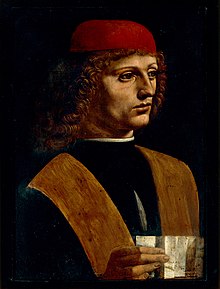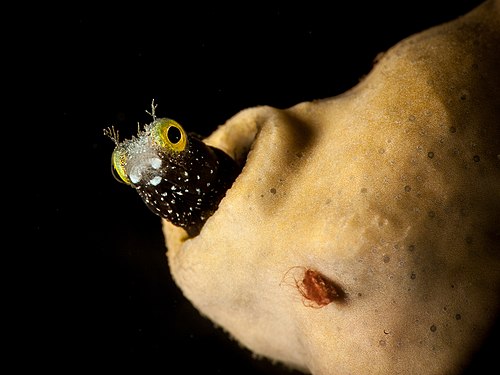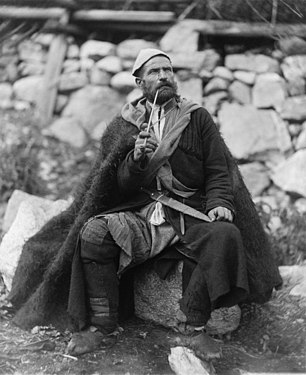Wikipedia:Wikipedia Signpost/2021-01-31/Featured content
New Year, same Featured Content report!

Well! A new year is upon us, so let's finish up the dregs of last year's featured content processes - we have to work a bit behind publication so that I can get this done in advance and not have to plan my life around finishing up the article on a specific date - and hope that that old cove, COVID-19, stops being just the worst guest and goes away soon. (As I keep saying: Stay safe, and look after yourselves, aye?)
I'm afraid I must confess to an error in the last report: the Royal Artillery Memorial was briefly miscredited: It should have said it was nominated by both Hchc2009 and HJ Mitchell. This is the problem with making these reports entirely by hand. Always plenty of room for error. I also failed to make the all-but-necessary joke for the article "Blank Space" until the second day of publication, which was also a mistake. I must do better. We'll deal with my other big mistake at the appropriate time, which is later in this report.
Speaking of which - and maybe this says more about what I listen to in the background when editing here than being a universal truth - but, ever notice all the podcasts and videos and such that tell you that if you like it, you can get more of the same by subscribing? ...Always thought you can do that much better by hitting replay. Or by having each bit of content posted to the podcast or Youtube channel or Featured Content Report be a repeat of the last one. No... um... reason for bringing that up.
Anyway! 2021 is upon us, and it's time to start a new year of Wikipedia. They do say that stating your intent can be helpful in getting things done, so my goal is to finally reach 100 featured pictures in a single year. We'll see how well I do with that. Feel free to state your Wikigoals (Which sounds like a new Wikimedia project. Would make New Year's resolutions far easier to achieve if you could edit them later...) in the comments below.
- -Adam
Featured articles
15 featured articles were promoted this period.

- Portrait of a Musician, nominated by Aza24
- The Portrait of a Musician is an unfinished painting widely attributed to the Italian Renaissance artist Leonardo da Vinci, dated to c. 1483–1487. Produced while Leonardo was in Milan, the work is painted in oils, and perhaps tempera, on a small panel of walnut wood. It is his only known male portrait painting, and the identity of its sitter has been closely debated among scholars. Perhaps influenced by Antonello da Messina's introduction of the Early Netherlandish style of portrait painting to Italy, the work marks a dramatic shift from the profile portraiture that predominated in 15th-century Milan. It shares many similarities with other paintings Leonardo executed there, such as the Virgin of the Rocks and the Lady with an Ermine, but the Portrait of a Musician is his only panel painting remaining in the city, where it has been in the Pinacoteca Ambrosiana since at least 1672. There are no extant contemporary records of the commission. Based on stylistic resemblances to other works by Leonardo, most current scholarship attributes at least the sitter's face to him. Uncertainty over the rest of the painting is due to the stiff and rigid qualities of the body, which are uncharacteristic of Leonardo's work. While this may be explained by the painting's unfinished state, some scholars believe that Leonardo was assisted by one of his students.
- 55th (West Lancashire) Infantry Division, nominated by EnigmaMcmxc
- The 55th (West Lancashire) Infantry Division was an infantry division of the British Army's Territorial Army (TA) that was formed in 1920 and existed through the Second World War, although it did not see combat. The division had originally been raised in 1908 as the West Lancashire Division, part of the British Army's Territorial Force (TF). It fought in the First World War, as the 55th (West Lancashire) Division, and demobilised following the fighting. In 1920, the 55th (West Lancashire) Division started to reform. It was stationed in the county of Lancashire throughout the 1920s and 1930s, and was under-funded and under-staffed. In the late 1930s, the division was reduced from three to two infantry brigades and gave up some artillery and other support units to become a motorised formation, the 55th (West Lancashire) Motor Division. This was part of a British Army doctrine change that was intended to increase battlefield mobility.
- Following the German occupation of Czechoslovakia, the division created new units around cadres of its own personnel, a process called "duplicating". The division then used these new formations to create its "duplicate", the 59th (Staffordshire) Motor Division. The 55th remained in the United Kingdom, in a defensive role, after the outbreak of the Second World War. In 1940, following the Battle of France, the motor division concept was abandoned. The division regained its third infantry brigade, and became the 55th (West Lancashire) Infantry Division. It remained within the United Kingdom, training for future operations as well as training replacements for combat units, and assigned to anti-invasion duties. By 1944, the division had been drained of many of its assets. The remnant of the division was used in Operation Fortitude, a deception effort that supported the Allied invasion of France. At the end of the war, the division was demobilised and not reformed.
- Battle of Powick Bridge, nominated by Harrias
- The Battle of Powick Bridge was a skirmish fought on 23 September 1642 just south of Worcester, England, during the First English Civil War. It was the first engagement between elements of the principal field armies of the Royalists and Parliamentarians. Sir John Byron was escorting a Royalist convoy of valuables from Oxford to King Charles's army in Shrewsbury and, worried about the proximity of the Parliamentarians, took refuge in Worcester on 16 September to await reinforcements. The Royalists despatched a force commanded by Prince Rupert. Meanwhile, the Parliamentarians sent a detachment, under Colonel John Brown, to try to capture the convoy. Each force consisted of around 1,000 mounted troops, a mix of cavalry and dragoons.
- The Parliamentarians approached the city from the south on the afternoon of 23 September. Their route took them up narrow lanes and straight into Rupert's force, which was resting in a field. The noise of the approaching Parliamentarian cavalry alerted the Royalists, who quickly formed up. The Royalist dragoons gave their cavalry time to prepare, firing at point-blank range as the Parliamentarians emerged into the field. Rupert's cavalry then charged and broke most of the Parliamentarian cavalry, though one troop stood its ground and returned fire. Ultimately, all of the Parliamentarians were routed.
- Brown protected his cavalry's escape by making a rearguard stand with his dragoons at Powick Bridge. Rupert gave chase as far as Powick village, but the Parliamentarian cavalry fled 15 miles (24 km) further, their flight causing panic among part of the main Parliamentarian field army. The Royalists abandoned Worcester, leaving safely with their valuable convoy. The Parliamentarian army arrived in the city the next day and remained for four weeks before shadowing the Royalist move towards London, which led to the Battle of Edgehill.

- Scorpion, nominated by LittleJerry and Chiswick Chap
- Scorpions are predatory arachnids of the order Scorpiones. They have eight legs, and are easily recognized by a pair of grasping pincers and a narrow, segmented tail, often carried in a characteristic forward curve over the back and ending with a stinger. They mainly live in deserts but have adapted to a wide range of environmental conditions, and can be found on all continents except Antarctica. There are over 2,500 described species, with 22 extant (living) families recognized to date.
- Scorpions primarily prey on insects and other invertebrates, but some species take vertebrates. They use their pincers to restrain and kill prey. Scorpions themselves are preyed on by larger animals. The venomous sting can be used both for killing prey and for defense, however, the vast majority of species do not represent a serious threat to humans, and healthy adults usually do not need medical treatment after being stung.
- Sonic the Hedgehog, nominated by TheJoebro64
- Sonic the Hedgehog is a Japanese video game series and media franchise created and owned by Sega. The franchise follows Sonic, an anthropomorphic blue hedgehog who battles the evil Doctor Eggman, a mad scientist. The main Sonic the Hedgehog games are platformers mostly developed by Sonic Team; other games, developed by various studios, include spin-offs in the racing, fighting, party and sports genres. The franchise also incorporates printed media, animations, a 2020 feature film, and merchandise.
- The first Sonic game, released in 1991 for the Sega Genesis, was developed after Sega requested a mascot character to compete with Nintendo's mascot Mario. Its success helped Sega become one of the leading video game companies during the fourth generation of video game consoles in the early 1990s. Sega Technical Institute developed the next three Sonic games, plus the spin-off Sonic Spinball (1993). After a hiatus during the unsuccessful Saturn era, the first major 3D Sonic game, Sonic Adventure, was released in 1998 for the Dreamcast. Sega exited the console market and shifted to third-party development in 2001, continuing the series on Nintendo, Xbox, and PlayStation systems.
- Laguna del Maule (volcano), nominated by Jo-Jo Eumerus
- Laguna del Maule is a volcanic field in the Andes mountain range of Chile, close to, and partly overlapping, the Argentina–Chile border, named after the Laguna del Maule lake within the field. The bulk of the volcanic field is in the Talca Province of Chile's Maule Region. It is a segment of the Southern Volcanic Zone, part of the Andean Volcanic Belt. The volcanic field covers an area of 500 square kilometres (190 sq mi) and features at least 130 volcanic vents. Volcanic activity has generated cones, lava domes, lava coulees and lava flows, which surround the Laguna del Maule lake. Between 2004 and 2007, ground inflation began in the volcanic field, indicating the intrusion of a sill beneath it. The rate of inflation is faster than those measured on other inflating volcanoes such as Uturunku in Bolivia and Yellowstone Caldera in the United States and has been accompanied by anomalies in soil gas emission and seismic activity. This pattern has created concern about the potential for impending large-scale eruptive activity.
- Warner Bros. Movie World, nominated by CR4ZE
- Warner Bros. Movie World is a theme park on the Gold Coast in Queensland, Australia. Owned and operated by Village Roadshow's Theme Parks division, the park opened on 3 June 1991. It is part of a 154-hectare (380.5-acre) entertainment precinct, with the adjacent Village Roadshow Studios and nearby Wet'n'Wild Gold Coast, among other properties operated by Village. Movie World is Australia's only film-related theme park and the oldest of the Warner Bros. parks worldwide (the others are at Madrid and Abu Dhabi). As of 2016, it receives a yearly average of 1.4 million visitors.
- Attractions range from thrill rides such as Batwing Spaceshot and Superman Escape to family attractions such as Wild West Falls Adventure Ride and Justice League: Alien Invasion 3D, entertainment at the Roxy Theatre and the Hollywood Stunt Driver live show. Among the six operating roller coasters, DC Rivals HyperCoaster is Australia's tallest, fastest and longest, and Green Lantern Coaster has the world's third-steepest drop angle. Film characters regularly roam the grounds to interact and take photos with guests. Each afternoon, characters participate in a parade along Main Street. The seasonal Fright Nights and White Christmas events are hosted annually.

- Buruli ulcer, nominated by Ajpolino
- Buruli ulcer is an infectious disease characterized by the development of painless open wounds. The disease is limited to certain areas of the world, most cases occurring in Sub-Saharan Africa and Australia. The first sign of infection is a small painless nodule or area of swelling, typically on the arms or legs. The nodule grows larger over days to weeks, eventually forming an open ulcer. Deep ulcers can cause scarring of muscles and tendons, resulting in permanent disability.
- Buruli ulcer is caused by skin infection with bacteria called Mycobacterium ulcerans. The mechanism by which M. ulcerans is transmitted from the environment to humans is not known, but may involve the bite of an aquatic insect or the infection of open wounds. Once in the skin M. ulcerans grows and releases the toxin mycolactone, which blocks the normal function of cells, resulting in tissue death and immune suppression at the site of the ulcer.
- The World Health Organization recommends treating Buruli ulcer with a combination of the antibiotics rifampicin and clarithromycin. With antibiotic administration and proper wound care, small ulcers typically heal within six months. Deep ulcers and those on sensitive body sites may require surgery to remove dead tissue or repair scarred muscles or joints. Even with proper treatment, Buruli ulcer can take months to heal. Regular cleaning and dressing of wounds aids healing and prevents secondary infections.
- Kaikhosru Shapurji Sorabji, nominated by Toccata quarta
- Kaikhosru Shapurji Sorabji (born Leon Dudley Sorabji; 14 August 1892 – 15 October 1988) was an English composer, music critic, pianist and writer whose musical output spanned eight decades and ranges from sets of miniatures to works lasting several hours. One of the most prolific 20th-century composers, he is best known for nocturnes such as Gulistān and Villa Tasca, and for his large-scale, technically intricate compositions, which include seven symphonies for piano solo, four toccatas, Sequentia cyclica and 100 Transcendental Studies. He felt alienated from English society by reason of his homosexuality and mixed ancestry, and had a lifelong tendency to seclusion.
- As a composer, Sorabji was largely self-taught. Although he was attracted to modernist aesthetics at first, he later dismissed much of the established and contemporary repertoire. He drew on diverse influences like Ferruccio Busoni, Claude Debussy and Karol Szymanowski and developed a style characterised by frequent polyrhythms, interplay of tonal and atonal elements and lavish ornamentation. Although he primarily composed for the piano, he also wrote orchestral, chamber and organ pieces. Sorabji has been likened to many of the composer-pianists he admired, including Franz Liszt and Charles-Valentin Alkan. Features of his works, not least their harmonic language and complex rhythms, anticipated trends in compositions from the mid-20th century onwards. His music remained largely unpublished until the early 2000s, but interest in it has grown since then.
- 2006 Football League Championship play-off Final, nominated by The Rambling Man
- The 2006 Football League Championship play-off Final was an association football match which was played on 21 May 2006 at the Millennium Stadium, Cardiff, between Leeds United and Watford. The match was to determine the third and final team to gain promotion from the Football League Championship, the second tier of English football, to the FA Premiership. Reading and Sheffield United, the top two teams of the 2005–06 Football League Championship season, gained automatic promotion to the Premiership, while the clubs placed from third to sixth place in the table took part in play-off semi-finals. Third-placed Watford defeated fourth-placed Preston North End in the first semi-final, while fifth-placed Leeds beat sixth-placed Crystal Palace. The winners of these semi-finals competed for the final place for the 2006–07 season in the Premiership. Watford won the match 3–0, with opening goalscorer Jay DeMerit named man of the match. Leeds goalkeeper Neil Sullivan scored an own goal to make the score 2–0 to Watford after 60 minutes, and the final goal was a penalty kick scored by Darius Henderson.

- Imaginative Tales, nominated by Mike Christie
- Imaginative Tales was an American fantasy and science fiction magazine launched in September 1954 by William Hamling's Greenleaf Publishing Company. It was created as a sister magazine to Imagination, which Hamling had acquired from Raymond A. Palmer's Clark Publishing. Imaginative Tales began as a vehicle for novel-length humorous fantasy, early issues featuring stories by Charles F. Myers and Robert Bloch. After a year, Hamling switched the focus to science fiction and it became similar in content to Imagination, publishing routine space operas. In 1958, with public interest in space high, Hamling changed the title to Space Travel, but there was little effect on sales. Magazine circulation was suffering because of the rise of the paperback, and the liquidation in 1957 of American News Company, a major magazine distributor, made it even harder for small magazines to survive. Hamling eventually folded both Imaginative Tales and Imagination in 1958, preferring to invest the money in Rogue, a men's magazine he had started in imitation of Playboy in 1955.
- John Young (astronaut), nominated by Balon Greyjoy
- John Watts Young (September 24, 1930 – January 5, 2018) was an American astronaut, naval officer and aviator, test pilot, and aeronautical engineer, and the ninth person to walk on the Moon. In 1962, Young was selected as a member of NASA Astronaut Group 2. He flew on the first crewed Gemini mission in 1965, and then commanded the 1966 Gemini 10 mission. In 1969, he flew as the command module pilot on Apollo 10. After that, he commanded Apollo 16, and spent three days on the lunar surface exploring the Descartes Highlands with Charles Duke. Young also commanded STS-1 in 1981, the Space Shuttle program's first launch, and STS-9 in 1983, both of which were on Columbia. Young served as Chief of the Astronaut Office from 1974 to 1987, and retired from NASA in 2004. He died in 2018 at the age of 87.
- Portsmouth War Memorial, nominated by HJ Mitchell
- The City of Portsmouth War Memorial, also referred to as the Guildhall Square War Memorial, is a First World War memorial in Guildhall Square in the centre of Portsmouth, Hampshire, on the south coast of England. Portsmouth was and remains a port and home to a major naval dockyard. The dockyard and the armed forces provided much of the employment in the area in the early 20th century. As such, the town suffered significant losses in the First World War. Planning for a war memorial began shortly after the end of the conflict and a committee was established for the purpose. It selected a site adjacent to a railway embankment close to the Town Hall (renamed the Guildhall in 1926 when Portsmouth was granted city status) and chose the architects James Gibson and Walter Gordon, with sculptural elements by Charles Sargeant Jagger, from an open competition.
- The memorial consists of a semi-circular sunken recess (exedra) with a screen wall. Bronze panels fixed to the wall list the names of the dead. Archways in the wall lead out of Guildhall Square towards Victoria Park and the railway station, and balustrades lead away back into Guildhall Square, terminating in sculptures by Jagger of a life-size soldier and sailor with machine guns. In the centre is a cenotaph surmounted with an urn and decorated on the sides with relief carvings of wartime scenes. Prince Arthur unveiled the memorial on 19 October 1921, before its completion.
- 2018 EFL League Two play-off Final, nominated by Amakuru
- The 2018 EFL League Two play-off Final was an association football match played on 28 May 2018 at Wembley Stadium, London, between Coventry City and Exeter City. The match determined the fourth and final team to gain promotion from EFL League Two, English football's fourth tier, to EFL League One. Coventry won 3–1 to earn promotion to the 2018–19 EFL League One. It was their first promotion for 51 years since being guided by Jimmy Hill into the 1967–68 Football League First Division. Marc McNulty, the Coventry striker was named the man of the match.
- "New Romantics" (song), nominated by HĐ
- "New Romantics" is a song recorded by American singer-songwriter Taylor Swift for the deluxe edition of her fifth studio album, 1989 (2014). It was written by Swift alongside its producers, Max Martin and Shellback. The song's title is a reference to the New Romantic cultural movement of the 1970s and 1980s; the new wave musical style of that era influenced the song's synth-pop production. The lyrics find Swift reigniting her hopes and energy after having endured emotional hardships. "New Romantics" was made available for digital download as a promotional single on March 3, 2015, by Big Machine Records. It was released to US radio as the seventh and final single from 1989 on February 23, 2016, by Republic Records in partnership with Big Machine.
Featured pictures
27 featured pictures were promoted this period.
-
Cliffs and coastline in the Jasmund National Park, by Moahim
-
Kaʻiulani. Unknown photographer, restored by Mark Miller
-
Entrance hall of the Eureka Inn, by Frank Schulenburg
-
Acanthemblemaria spinosa, the spinyhead blenny, by q-phia
-
Collapse of the Arecibo Telescope, by the National Science Foundation
-
Poster for Victor Herbert's The Fortune Teller, by The U.S. Lithograph Co., restored by Adam Cuerden
-
Bicycle crankset, by Petar Milošević
-
Poster for the 1933 film State Fair, by Twentieth Century–Fox Film Corp [sic], restored by Adam Cuerden
-
Svan peasant in traditional dress. Unknown photographer, restored by Adam Cuerden
-
Nassau grouper, by q-phia
-
Valerie Thomas next to a stack of the Landsat Computer Compatible Tapes she worked out the image formats for. Photograph by NASA, restored by Adam Cuerden
Featured lists
18 featured lists were promoted this period. An additional one, which was promoted 3 January, was included to complete a set.

- List of Odonata species of Slovenia, nominated by Yerpo
- The Odonata species of Slovenia include 72 species of dragonflies and damselflies (Slovene: kačji pastirji) for which reliable records exist from the present territory of Slovenia, including one that has not been seen since the 1960s and is presumed extirpated (locally extinct), but may have simply been overlooked. The list is based on two reference works: Atlas of the Dragonflies (Odonata) of Slovenia, a joint publication from 1997 of the Slovene Odonatological Society and the Slovene Centre for Cartography of Fauna and Flora, and the newer Atlas of the European dragonflies and damselflies (2015), supported by other, more recent publications in which new species found after 1997 were documented.
- List of What Would You Do? episodes, nominated by Some Dude From North Carolina
- What Would You Do? (commonly abbreviated as WWYD, and formerly known as Primetime: What Would You Do? through the program's fifth season) is an American situational hidden camera television series that has been broadcast on the American Broadcasting Company (ABC) since February 26, 2008. Created by Chris Whipple, the show follows the reactions of passing strangers as they encounter conflict or illegal activity in a public setting, unaware that its all staged and being recorded with hidden cameras. Throughout all of its sixteen seasons, the show has been hosted by news correspondent John Quiñones

- List of World Heritage Sites in Belarus, nominated by Tone
- The United Nations Educational, Scientific and Cultural Organization (UNESCO) World Heritage Sites are places of importance to cultural or natural heritage as described in the UNESCO World Heritage Convention, established in 1972. Belarus accepted the convention on 12 October 1988, making its natural and historical sites eligible for inclusion on the list. As of 2020[update], there are four World Heritage Sites in Belarus. The first site in Belarus added to the list was the Białowieża Forest in 1992, representing an extension to the site previously listed in Poland in 1979. This is the only natural site in Belarus, the other three are cultural. In addition to Białowieża Forest, the Struve Geodetic Arc is also a transnational site, and is shared with nine other countries. As of 2020[update], Belarus has five sites listed on the tentative list, all were added in 2004.
- List of Burnley F.C. managers, nominated by WA8MTWAYC
- Burnley Football Club is an English professional association football club based in the town of Burnley, Lancashire. Founded on 18 May 1882, the club was one of the first to become professional (in 1883), putting pressure on the Football Association to permit payments to players. As a result, the team were able to enter the FA Cup for the first time in 1885–86, and were one of the twelve founding members of the Football League in 1888–89. Burnley have played in the top four tiers of English football from 1888 to the present day. The team have been champions of England twice, in 1920–21 and 1959–60, have won the FA Cup once, in 1913–14, and have won the FA Charity Shield twice, in 1960 and 1973. Burnley were the second, and are one of only five teams to have won all four professional divisions of English football, along with Wolverhampton Wanderers, Preston North End, Sheffield United and Portsmouth.

- Dayahang Rai filmography, nominated by CAPTAIN MEDUSA
- Dayahang Rai is a Nepalese actor, director and play writer known for his work in Nepali cinemas. He is one of the most popular and acclaimed actors in Nepal. He has starred in 40 plus films and is one of the leading contemporary actors in Nepal. Dayahang rose to prominence from the television series Yuva, Dalan and Hamro Team. His first leading role in a film was in Anagarik (2006) and had only one successful film Dasdhunga (2010) to his name but the 2012 Industry Hit film Loot (2012) marked turning point in his career and since then has starred in successful films Chhadke (2013), Badhshala (2013), Karkash (2013), Jholey (2014), Kabaddi (2013) and its sequels Kabaddi Kabaddi (2015) and Kabbadi Kabbadi Kabbadi (2019), Talakjung vs Tulke (2014), Woda Number 6 (2015), How Funny (2016), Bir Bikram (2016), Loot 2 (2017), Kaanchi (2018) and Jatrai Jatra (2019). He has starred in the film White Sun (2016) which was his first film that was entry of Nepal for Academy Awards.
- Dayahang Rai is also the recipient of numerous awards including three National Awards for Best Supporting Actor in 2009 for Dasdhunga, Best Actor in 2015 for Sambodhan, and Best Actor in 2016 for Kabaddi Kabaddi. (Text from Dayahang Rai for reason of length and wanting to accurately hit career highlights))
- List of Billboard number-one country songs of 1949, nominated by ChrisTheDude
- In 1949 Billboard magazine published three charts covering the best-performing country music songs in the United States. At the start of the year, the magazine published two charts covering the genre: Most-Played Juke Box Folk Records, which had appeared in Billboard since 1944, and Best Selling Folk Retail Records, which had debuted in 1948. With effect from the issue of the magazine dated June 25, Billboard began using the term "country and western" for the first time in the titles of the charts, renaming the juke box chart to Most-Played Juke Box (Country & Western) Records and the best sellers chart to Best-Selling Retail Folk (Country & Western) Records. In December the magazine added a third country chart when it began publishing the Country & Western Records Most Played By Folk Disk Jockeys listing. All three charts are considered part of the lineage of the current Hot Country Songs chart, which was first published in 1958.

- Dimple Kapadia filmography, nominated by Shahid
- Dimple Kapadia (born 8 June 1957) is an Indian actress who predominantly appears in Hindi films. She was discovered at age 14 by Raj Kapoor, who cast her in the title role of his teen romance Bobby (1973), which achieved commercial success and gained her wide public recognition. In the same year, she married the Indian actor Rajesh Khanna and retired from acting. Kapadia returned to films in 1984, two years after her separation from Khanna. Her comeback film Saagar, which was released a year later, revived her career. Both Bobby and Saagar won her Filmfare Awards for Best Actress. Through her work over the decade, she established herself as one of Hindi cinema's leading female actors.
- Kapadia's initial roles often relied on her perceived beauty and sex appeal but she was keen to challenge herself and expand her range. She took on more serious parts of troubled women in films ranging from mainstream to neorealist parallel cinema, and received acclaim for her performances in films including Kaash (1987), Drishti (1990), Lekin... (1991), and Rudaali (1993). For her role as a professional mourner in Rudaali, she won the National Film Award for Best Actress and the Filmfare Critics Award for Best Actress. Kapadia followed with supporting roles in Gardish (1993) and Krantiveer (1994), the latter of which garnered her a fourth Filmfare Award.
- Starting in the 1990s, Kapadia became more selective about her roles, and her work over the following decades was infrequent, with substantial gaps, but included several notable films, such as Dil Chahta Hai (2001) Leela (2002), Luck by Chance (2009), Finding Fanny (2014), and, most recently, the Christopher Nolan film Tenet (film) (2020). (Text largely from Dimple Kapadia, for reason of length and wanting to accurately hit career highlights)
- List of operas by Carl Maria von Weber, nominated by Aza24
- The German composer Carl Maria von Weber (1786–1826) is best known for his operas, of which he wrote 10 between 1798 and 1826. His first four exist in various states: Die Macht der Liebe und des Weins (comp. 1798) is completely lost; two fragments survive for Das Waldmädchen (1800); the libretto to Peter Schmoll und seine Nachbarn (1803) is lost; and only three numbers from Rübezahl (comp. 1804–05) survive. Weber's mature operas – Silvana (1810), Abu Hassan (1811), Der Freischütz (1821), Die drei Pintos (comp. 1820–21), Euryanthe (1823), Oberon (1826) – all survive intact; they were all performed within his lifetime, except Die drei Pintos which was posthumously completed by Gustav Mahler. His contributions to the genre were crucial in the development of German Romantische Oper (German Romantic Opera) and its national identity, exhibiting much influence on Richard Wagner. Der Freischütz, his most famous and significant work, remains among the most revered German operas.

- List of avisos of Germany, nominated by Parsecboy
- The German navies, beginning with the Prussian Navy in the 1840s, acquired a series of avisos for use in a variety of roles, including as scouts, flagships for gunboat flotillas, and dispatch vessels. The first such vessel, SMS Preussischer Adler, was a packet steamer requisitioned for service during the First Schleswig War in 1848, though she returned to civilian duty after the war. In 1850, the Prussians ordered a pair of small vessels—the Nix class—from Britain; like Preussicher Adler, these were both paddle steamers. The first screw-driven aviso followed in 1856: the French-built Grille. Another paddle steamer, Loreley, was laid down in 1858, the first vessel of the type built in a German shipyard. Many of these vessels served as yachts for the royal and later imperial family. During the Second Schleswig War, Loreley and Preussischer Adler saw action at the Battles of Jasmind and Heligoland, respectively.
- At the start of the Franco-Prussian War in 1870, the Prussians purchased Falke and requisitioned Pommerania. Grille engaged French forces in the Baltic during the war, but the rest of the fleet's avisos saw little activity in the conflict. Zieten, the first torpedo-armed aviso to be built for what was now the German Imperial Navy, was also the last major warship to be built abroad for the Imperial German fleet. The 1880s saw a significant aviso construction program that included two Blitz-class avisos, Greif, two Wacht-class avisos, and two Meteor-class avisos. The latter two classes were disappointments in service owing to their small size, insufficient speed, and in the case of the Meteors, excessive vibration from their engines. SMS Hela, the last vessel of the type to be built for the Imperial fleet, was completed in 1895. The Germans thereafter built light cruisers that fulfilled the roles occupied by the avisos; the first of these, the Gazelle class, combined the best features of Hela with those of contemporary unprotected cruisers. Hela was herself sunk in September 1914 during World War I; the other vessels still in service saw little active use during the war and were all broken up afterward.
- One final vessel, Grille, was built in the mid-1930s for use as a yacht for Adolf Hitler. During World War II, she was used as a minelayer, a training ship, and a stationary headquarters ship in Norway before being seized by Britain. She was sold after the war to a private owner and was ultimately scrapped in 1951.
- List of Xevious media, nominated by Namcokid47
- Xevious is a shoot 'em up video game franchise published by Bandai Namco Entertainment, formerly Namco. The eponymous first entry was released for arcades in January 1983 in Japan and a month later in North America by Atari. It was created by Masanobu Endo, who is also known as the creator of The Tower of Druaga The game received multiple sequels, spin-offs, and re-imaginings, the latest being Xevious Resurrection from 2009. Xevious games have been ported to many platforms and compiled into several Namco compilations. The franchise contains twelve games—seven mainline entries and five spin-offs—soundtrack albums, pachinko machines, and an animated feature film produced by Groove Corporation.
- Gameplay in the series consists of controlling a spaceship named the Solvalou throughout a series of levels, shooting at enemies and avoiding their projectiles. Critics have retrospectively labeled it as being among the most important games of its kind. It is credited as the first vertical-scrolling shooter, and among the first video games to implement bosses and a cohesive world and storyline. Xevious inspired games such as Gradius, TwinBee, Zanac, and RayForce.

- List of Pomona College people, nominated by Sdkb
- Pomona College is an elite private liberal arts college in Claremont, California, and the founding member of the Claremont Colleges. Many notable individuals have been affiliated with the college as graduates, non-graduating attendees, faculty, staff, or administrators. Since its founding in 1887, Pomona has graduated 127 classes of students. As of the fall 2020 semester, the college enrolls approximately 1,460 students and has roughly 25,000 living alumni.
- List of plant genus names (A–C), nominated by Johnboddie, and List of plant genus names (L–P) and List of plant genus names (Q–Z), nominated by Dank
- See "List of plant genus names (D–K)" in last issue. Now, I don't want to diminish the achievement these featured lists represent: lists are only divided up when amount of content is simply too large to put on one webpage - even within the limits these lists set, which, for example, unlike my old biology professor, don't put the fungi under plants, and don't appear to include synonyms or obsolete names - is a ridiculously massive project, with around 600 meticulously-referenced and documented items in each of these pages, with a total of 2450 plant genera over the four lists. However, while each of them is rightfully a featured list in their own right, they are, at the same time, parts of the same, larger list, with pretty much exactly the same introduction. And it's the introduction we quote here, not the masses of work after that. Unless we write a description like this one, I suppose.
- List of Vampire: The Masquerade books, nominated by Alexandra IDV
- Vampire: The Masquerade is a tabletop role-playing game in the World of Darkness series, in which players take the roles of vampires. It was originally released by White Wolf Publishing in 1991, and new editions were released in 1992 (second edition), 1998 (Revised Edition), 2011 (20th Anniversary Edition), and 2018 (fifth edition), each of which updated the game rules.
- Supplementary game books include: the By Night series, each of which cover a real-world city, and describe how it is handled within the setting; the Clanbook series, covering the vampire clans; guides to the game; sourcebooks for sects and factions; and various other books. The supplements often introduce gradual change to the game's setting, advancing the overarching narrative. Adventure modules have been released, but only rarely, as White Wolf Publishing has preferred to let storytellers construct their own adventures, an uncommon choice in tabletop role-playing games that they could afford due to the World of Darkness series' success and longevity.
- 91st Academy Awards, nominated by Birdienest81
- The 91st Academy Awards ceremony, presented by the Academy of Motion Picture Arts and Sciences (AMPAS), honored the best films of 2018 and took place on February 24, 2019, at the Dolby Theatre in Hollywood, Los Angeles. During the ceremony, AMPAS presented Academy Awards (commonly referred to as Oscars) in 24 categories. The ceremony was televised in the United States by the American Broadcasting Company (ABC) and was produced by Donna Gigliotti and Glenn Weiss, with Weiss also serving as director. This was the first telecast to have no host since the 61st ceremony held in 1989.
- Green Book won three awards including Best Picture. Other winners included Bohemian Rhapsody with four awards, Black Panther and Roma with three awards, and Bao, BlacKkKlansman, The Favourite, First Man, Free Solo, If Beale Street Could Talk, Period. End of Sentence., Skin, Spider-Man: Into the Spider-Verse, A Star Is Born, and Vice with one. The telecast garnered 29.56 million viewers in the United States.

- List of herpestids, nominated by PresN
- This list appeared in both of the previous two featured content reports. With different herpestids illustrating it. See, last issue covered things from 12 November to 11 December, but the lists are assembled from Wikipedia:Goings-on which archives in convenient one-week archives, which start on a Sunday, and 12 November is a Thursday, meaning I should have ignored anything from that week that promoted before Thursday. But having failed to do that for "List of herpestids" once already ...Well, it seems a shame to break a tradition at this point.
- List of Billboard number-one country songs of 1950, nominated by ChrisTheDude
- In 1950, Billboard magazine published three charts covering the best-performing country music songs in the United States: Most-Played Juke Box (Country & Western) Records, Best-Selling Retail Folk (Country & Western) Records, and Country & Western Records Most Played By Folk Disk Jockeys. The juke box chart was compiled based on a "weekly survey among a selected group of jukebox operators whose locations require country and western records", the best sellers chart based on a "survey among a selected group of retail stores, the majority of whose customers purchase country and western records", and the jockeys chart based on a "weekly survey among a select list of over 400 disk jockeys specializing in country and western tunes". All three charts are considered part of the lineage of the current Hot Country Songs chart, which was first published in 1958.
- In the first issue of Billboard of 1950, Christmas songs were at number one on two charts, with "Blue Christmas" by Ernest Tubb in the top spot on the juke box chart and Gene Autry's recording of "Rudolph the Red-Nosed Reindeer" atop the jockeys chart. The number one on the best sellers chart was "Slipping Around" by Margaret Whiting and Jimmy Wakely, which had held the top spot since the previous October. The longest-running number one of 1950 on all three charts was "I'm Movin' On" by Canadian singer Hank Snow, which spent 14 weeks in the top spot on the juke box chart, 18 on the best sellers listing, and 17 on the jockeys chart. The song would spend three further weeks at number one on the best sellers chart in 1951, tying the record set in 1948 by Eddy Arnold's "I'll Hold You in My Heart (Till I Can Hold You in My Arms)" for the highest number of weeks spent at number one on any one of Billboard's country singles charts. Red Foley spent the highest total number of weeks at number one on both the juke box and best sellers charts in 1950, topping each for 19 weeks. He also had the highest number of individual chart-toppers on each of the two listings, with four and three respectively. On the jockeys chart, Hank Williams was the only artist with more than one number one hit, and he also spent the most weeks at number one, totalling 19 weeks in the top spot with his three chart-toppers.
- List of Bluey (2018 TV series) episodes, nominated by SatDis
- Bluey is an Australian animated television series for preschool children that premiered on ABC Kids on 1 October 2018. The series was created by Joe Brumm with Queensland production group Ludo Studio. The show follows Bluey, an anthropomorphic six-year-old Blue Heeler puppy who is characterised by her abundance of energy, imagination and curiosity of the world. The young dog lives with her father, Bandit; mother, Chilli; and younger sister, Bingo, who regularly joins Bluey on adventures as the pair embark on imaginative play together. Other characters featured are each depicted as a different dog breed, some inspired by dogs from Brumm's childhood. Overarching themes include the influence of a supportive family, Australian culture, and the importance of play throughout childhood.
- List of diplomatic missions of Taiwan, nominated by MSG17
- Taiwan, officially the Republic of China, has 112 diplomatic missions across the world as of December 2020[update]. Due to the One-China policy, other countries are only allowed to maintain relations with either Taiwan or the mainland-based People's Republic of China. As most countries have changed their recognition to the latter over time, only 17 of Taiwan's diplomatic missions have official status, consisting of fifteen embassies and two consulate-generals. This makes Taiwan one of the few countries in the world that has resident embassies in all of the states with which it has formal diplomatic relations.
- Despite these barriers, 57 United Nations members maintain relations with Taiwan on an unofficial basis. In addition, Taiwan has informal relations with Somaliland, a state that is not internationally recognized by any other country, including China. To serve these locations and other places throughout the world, 92 semi-official representative offices are utilized for matters that would otherwise be handled by embassies or consulates. Their heads are still appointed by the Ministry of Foreign Affairs, making them de facto missions. Owing to pressure from China, most of these offices cannot operate under either the country's official or common name, using the name of the capital Taipei instead to avoid addressing Taiwan's political status. The only exception is the representative office in Somaliland, which has "Taiwan" in its name.





















![Poster for the 1933 film State Fair, by Twentieth Century–Fox Film Corp [sic], restored by Adam Cuerden](http://upload.wikimedia.org/wikipedia/commons/thumb/5/5b/State_Fair_%281933_film_poster%29_-_Restoration.jpg/246px-State_Fair_%281933_film_poster%29_-_Restoration.jpg)









Discuss this story